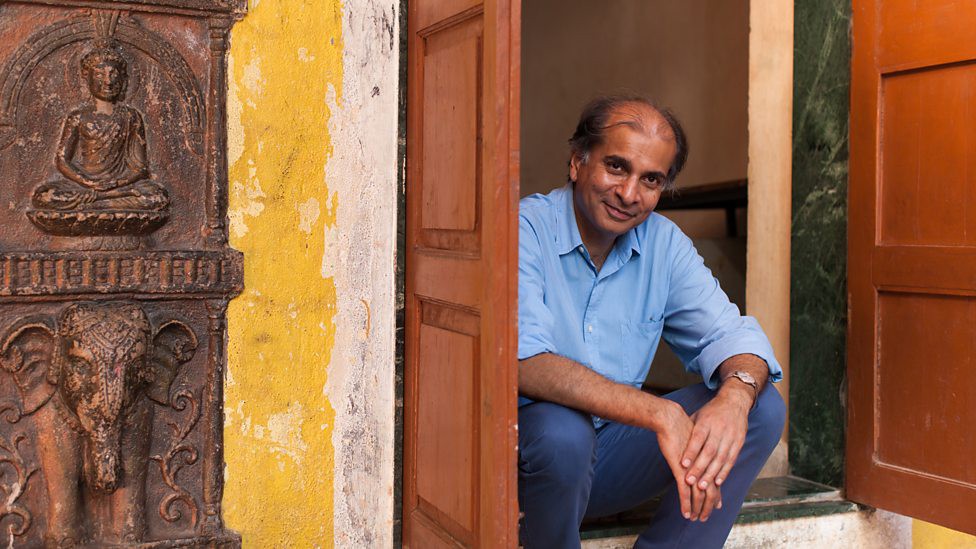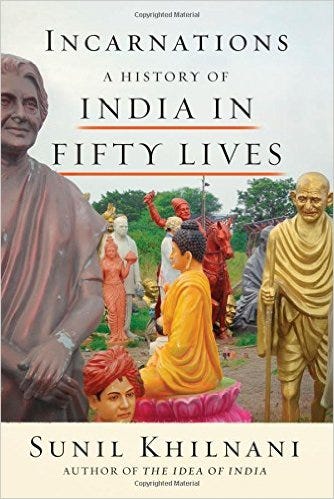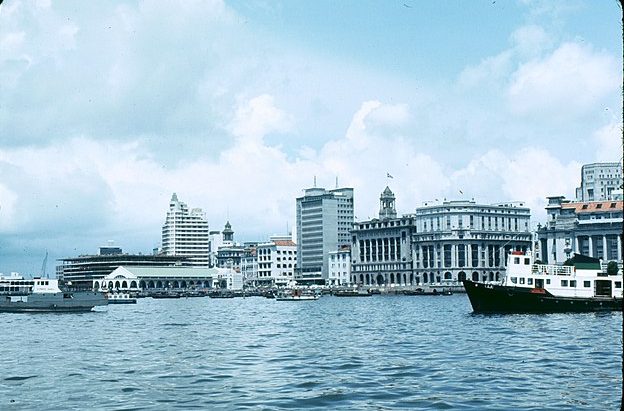Books & Culture
Reviving India’s Heroes & Heroines
Sunil Khilnani on breathing new life into a nation’s icons.

From the outside, India evokes so much — the Taj Mahal, yoga, the caste system and so on — but save for a few deified figures such as the Buddha and Gandhi, India’s history, as Sunil Khilnani writes in the opening of Incarnations: A History of India in Fifty Lives (FSG, 2016), is a “curiously unpeopled place.” The collection of essays does much to correct this impression by introducing and re-introducing readers to the leaders, poets, performers, and rebels who’ve shaped India.

Incarnations’ cast is extremely characterful. A random selection: Muhammad Ali Jinnah, lawyer and founder of Pakistan; actor and Bollywood patriarch Raj Kapoor; Indo-Hungarian painter Amrita Sher-Gill, and Ethiopian-born Malik Ambar, who went from being an enslaved mercenary to a power broker and the military bane of the Mughal Empire.
All fifty subjects are dead but Khilnani renders them in an intimate light. In doing so, he complicates any glory they’ve enjoyed as figureheads of contemporary causes in India. I spoke to Khilnani about how he populated the book and Indian history, beginning in the fifth century BCE up until the early 2000s.
J.R. Ramakrishnan: Incarnations narrates the long arc of Indian history from the Buddha onwards through the stories of fifty lives. What an impressive project of curation these profiles must have been! How did you decide who made the cut? And how long did the entire project take? I was also wondering which characters did not make the cut (or almost made the cut) if you’d care to share that.
Sunil Khilnani: It was a real sweat cutting down to the 50 individuals I’ve ended up with! I wanted figures drawn from a broad range of creative activities (so I have poets and painters, mathematicians and musicians, emperors and freedom fighters, photographers and philosophers, scholars and businessmen), drawn from all parts of India, and across 2,500 years of history. Most of the lives I’ve chosen also allow me to explore many of the persisting contradictions and conflicts in Indian history: they straddle the fissures of religion, caste, gender, region, and individuality and social norms. Very many of them have also had afterlives — recycled at different points in history, and deployed to fight current battles. Indeed, that’s one of the meanings of my title, Incarnations: lives that get revived. Finally, all of the 50 had to be real historical people (not figures from myths or epics), and all had to be dead.
I have been thinking about Indian history and how to tell it for many years. In the end though, it took me two years of concentrated work to write the book and to make the 50 podcasts and radio programs which I did with the BBC. Working with multiple deadlines, in different media, and with a great deal of travel involved, was at once exciting and a huge strain — not least on my wife, Katherine Boo!
The names that didn’t make it, well, you know, it’s like a limb you may have lost. Once it’s gone, you no longer dwell on it, you take satisfaction in what you have and not in regretting what you may be missing.
JRR: I imagine that your choices, your critical eye upon certain legacies, and your shedding of light on now-appropriated figures, must have elicited some strong responses. Indeed, you write in the introduction that this what you hope for but I am curious to know what you think of conversations that have resulted since the book’s publication, especially in India.
SK: The reception of my book, both in India and in Britain, has been incredibly generous and positive. I’m particularly heartened by the response in India — it seems to have caught the imaginations of younger readers, whom I really want to reach (a special edition for young readers will come out next year). Most young Indians have encountered the people I write about only in boring school lessons, or as hollow statues, glamorized images, or road names. So, to be able read about them as real human beings with all their foibles and quirks, can open up new ways of thinking about the past — and its relationship to the present. In my book, you encounter legendary or mythic figures — like, for instance: Ashoka, Kabir, Guru Nanak, Amrita Sher-Gil, Subhas Chandra Bose, Jinnah, Indira Gandhi or Dhirubhai Ambani — as complicated human characters, with weakness and failings as well as with extraordinary qualities. I wanted to de-mythologize these figures, in order to re-humanize them a little.
I wanted to de-mythologize these figures, in order to re-humanize them a little.
Many of the conversations I’ve had since the book came out center on all figures who people feel I should have included: why not a sports player, what about that musician, or this scientist, that leader, and hey, how about this actress and so on! Now, I welcome that sort of discussion. I want this book exactly to provoke such conversations: about who are the people who have made India’s history, why they are important, why they deserve our consideration. I never intended my book to install a pantheon, or to close down argument about which figures are important. Incarnations is an invitation to a conversation, a debate, about India’s past — and its future!
JRR: You write about the recycling (and often deification) of historical figures for use in various contemporary projects (e.g. first century military strategist Kautilya being used in Pakistani military schools or the poet Kabir at the Jaipur Literary Festival). Would you say that this is an especially Indian characteristic?
SK: I don’t think it’s an especially Indian characteristic, if by that you mean something like a cultural trait. After all, many societies turn to their past heroes for present purposes: in the US, George Washington, Jefferson, Hamilton, Roosevelt are constantly invoked. In the UK, it’s Churchill, and so on. But it happens even more in India, because of the current political situation there, which is a very divided one, with different caste and religious groups, different regions, each seeking to assert their own interests. And they all use history to try to do that. So you get a much greater investment in historical figures, and many more of them are invoked in current political argument. Something which might be more of an Indian trait, though, is the deification and mythification of these figures: the reluctance to see them as human beings in the round, with their flaws as well as their qualities.
JRR: In your profile of Periyar, the anti-Brahmin activist, you write that based on his look (“a bulky man in a black shirt with a bald head, untamed white beard, and beside him a little pet dog to scare away Brahmins”) you felt that you were in the company of a beat poet. You certainly offer close insight into the personalities of these characters, which is impressive since quite a few have been dead for centuries. Could you tell us about your research and reporting process? I imagine you must have travelled a great deal. What were the most memorable stories of the book’s journey for you?
SK: Thanks. So many of these figures are remote from us in time, culture and beliefs, and so I really did work hard to try to bring them alive, and to give readers an intimate sense of what it was like to inhabit their worlds, and even their minds. To do that, I worked with primary materials wherever they existed, with the direct words or writings of the people I was studying — as well looking at how those around them saw them. In addition to archives and texts, I also travelled to the places where they lived or worked — soaking up the land and streetscapes, the sounds, the light — and used all of those details to imagine their worlds, their anxieties, and hopes.
Let me give you an example. When I was researching the life of Kabir, the 15th century radical poet who lived in Benares or Varanasi, I spent time in one of that city’s poorest neighborhoods, where a community of Muslim weavers live, barely scraping an existence. This was the same community from which Kabir came, and seeing the conditions in which the present-day community live, I could really grasp the sheer rage which motivated Kabir, and which shaped into his unforgettable poetry.
I should also say that I was privileged to be able to talk to some of the finest scholars of and intellectuals from India, and through them learn more about these individuals and their times.
JRR: My personal favorite was the profile of the mercurial V.K. Krishnan Menon, Jawaharlal Nehru’s political operative. My father’s family has roots in Kerala and the temperament you described seemed more than a little familiar to me. I wasn’t aware that he’d a hand in the founding of Penguin Books so that was an exciting discovery for me. The story about you sitting down with what you hoped was an important box of his archives only to find instead his old hairbrush had me in stitches. Could you talk about the humor of many of your characters, and the role it played in constructing the profiles of this book?
SK: I’m so glad you highlighted this. I’ve tried always to bring out the humor of my characters, as well as the ironies and absurdities of how they are nowadays memorialized. Too often these ‘greats’ are presented as po-faced, venerable elders. Yet the fact, is that when they made their reputations they were almost all young, brash rabble rousers, with sharp tongues and scathing wit. Periyar would be a good example; or even Guru Nanak, in the provocative way in which he chose to dress — a sartorial farrago, as I describe it. Or take another example, Lakshmi Bai, the Rani or Queen of Jhansi who led an uprising against the British in 1857. She’s treated as a demi-goddess in India. She appears everywhere frozen in a ubiquitous icon: astride a horse, sword held high, her son cling to her back, as she leaps over the ramparts of her besieged hilltop fort. But, drawing on the contemporary memoirs of a Brahmin who spent time at her court, I was able to show how, while she engaged in strenuous physical routines and exercise (unlike her cross-dressing husband), and was physically impressive, in fact she probably slipped out of the fort by a special back door. Or another example: the way I show Mahatma Gandhi to be a brilliant, painstaking manager of the media, even while he claimed always to be guided by his spontaneous ‘inner voice.’ There is something laugh-worthy in this gap between burnished reputation and actual human choices though noticing such a gap does not diminish the people I write about. If anything, by seeing them as human like us, their very real achievements become all the more remarkable.
JRR: You link the lives in Incarnations to the contemporary moment in not just in India, but also the rest of the world. You liken Kautilya’s torture methods in his Arthashastra treatise to the 2014 U.S. Senate Select Committee on Intelligence report on the CIA’s interrogation techniques and later on, you open the profile of Ambedkar, the Dalit statesman who drafted the Indian constitution, with a quote from Ta-Nehisi Coates and compare the Dalit cause with the struggle for civil rights in Black America. What do you hope will be the greatest take away from the book for those less familiar with Indian history, say perhaps your non-Indian, non-Indian diaspora and non-Indophile readers?
SK: There are two big takeaways. First, that India’s history and the people who made it — even if you go back 2,500 years to figures like the Buddha or Ashoka — are living presences in contemporary India. Present-day Indians turn to these historical lives in their struggles to make their own lives better. Second, that Indian history is not a niche interest, for a couple of reasons: because India, which is home to almost 20% of the world’s population, and to an economy growing faster than any other major economy, matters more and more to the world. And because the dramatic sweep of the Indian past, the reach of Indian ideas, the stakes of India’s struggles both with itself and with alien colonizers, are central to the story of human history as a whole: to our ideas of power, of justice, of economic growth, and of freedom, as they apply to the entire human race.
The stakes of India’s struggles both with itself and with alien colonizers, are central to the story of human history as a whole…
JRR: And finally, who is your most beloved character of the fifty?
SK: I was most moved by the story of Birsa Munda — born into an Adivasi or tribal community in central India towards the end of the 19th century, he grew up wandering the forests around his village and mastering special healing skills. But he saw his people being dispossessed by the the British colonialists, by Christian missionaries, and exploitative Indian middlemen. And so he decided to fight for the rights of his people over the forest and the land. He became something of a religious teacher, and led an uprising. It was suppressed, he was captured, and died in jail, barely 23 years old. His story resonates very powerfully with the present-day struggles of India’s Adivasis and all the country’s dispossessed citizens.









